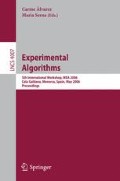Abstract
We present two efficient and simple fault attacks on the shrinking generator. In a first case if the attacker can stop control generator for some small number of steps and observe the output, then with high probability he can deduce the full control sequence, and so the other input bitstream. The second method assumes that the attacker can disturb the control sequence (in an unpredictable and random way) and observe many samples of such experiments. Then he can reconstruct a certain sequence that agrees with the input sequence of the generator on a large fraction of bits.
Partially supported by KBN project no. 0T00A 003 23.
Access this chapter
Tax calculation will be finalised at checkout
Purchases are for personal use only
Preview
Unable to display preview. Download preview PDF.
References
Beth, T., Piper, F.C.: The Stop-and-Go Generator. In: Beth, T., Cot, N., Ingemarsson, I. (eds.) EUROCRYPT 1984. LNCS, vol. 209, pp. 88–92. Springer, Heidelberg (1985)
Boneh, D., DeMillo, R.A., Lipton, R.J.: On the Importance of Checking Cryptographic Protocols for Faults. In: Fumy, W. (ed.) EUROCRYPT 1997. LNCS, vol. 1233, pp. 37–51. Springer, Heidelberg (1997)
Coppersmith, D., Krawczyk, H., Mansour, Y.: The Shrinking Generator. In: Stinson, D.R. (ed.) CRYPTO 1993. LNCS, vol. 773, pp. 22–39. Springer, Heidelberg (1994)
Chambers, W., Gollmann, D.: Clock-Controlled Shift Registers: A Review. IEEE J. Selected Areas Comm. 7(4), 525–533 (1989)
Dawson, E., Dj. Golič, J., Simpson, L.: A Probabilistic Correlation Attack on the Shrinking Generator. In: Boyd, C., Dawson, E. (eds.) ACISP 1998. LNCS, vol. 1438, pp. 147–158. Springer, Heidelberg (1998)
Ekdahl, P., Johansson, T., Meier, W.: Predicting the Shrinking Generator with Fixed Connections. In: Biham, E. (ed.) EUROCRYPT 2003. LNCS, vol. 2656, pp. 330–344. Springer, Heidelberg (2003)
Geffe, P.R.: How to Protect Data with Ciphers That Are Really Hard to Break. Electronics, 99–101 (January 4, 1973)
Dj. Golič, J., O’Connor, L.: Embedding and Probabilistic Correlation Attacks on Clock-Controlled Shift Registers. In: De Santis, A. (ed.) EUROCRYPT 1994. LNCS, vol. 950, pp. 230–243. Springer, Heidelberg (1995)
Gomułkiewicz, M., et al.: Synchronization Fault Cryptanalysis for Breaking A5/1. In: Nikoletseas, S.E. (ed.) WEA 2005. LNCS, vol. 3503, pp. 415–427. Springer, Heidelberg (2005)
Krause, M., Lucks, S., Zenner, E.: Improved Cryptanalysis of the Self-Shrinking Generator. In: Varadharajan, V., Mu, Y. (eds.) ACISP 2001. LNCS, vol. 2119, pp. 21–35. Springer, Heidelberg (2001)
Meier, W., Staffelbach, O.: The Self-shrinking Generator. In: De Santis, A. (ed.) EUROCRYPT 1994. LNCS, vol. 950, pp. 205–214. Springer, Heidelberg (1995)
Mihaljevic, M.: A Faster Cryptanalysis of the Self-shrinking Generator. In: Pieprzyk, J.P., Seberry, J. (eds.) ACISP 1996. LNCS, vol. 1172, pp. 182–188. Springer, Heidelberg (1996)
Rao, T.R.N., Yang, C.-H., Zeng, K.: An Improved Linear Syndrome Algorithm in Cryptanalysis With Applications. In: Menezes, A., Vanstone, S.A. (eds.) CRYPTO 1990. LNCS, vol. 537, pp. 34–47. Springer, Heidelberg (1991)
Zenner, E.: On the Efficiency of the Clock Control Guessing Attack. In: Lee, P.J., Lim, C.H. (eds.) ICISC 2002. LNCS, vol. 2587, pp. 200–212. Springer, Heidelberg (2003)
Author information
Authors and Affiliations
Editor information
Editors and Affiliations
Rights and permissions
Copyright information
© 2006 Springer-Verlag Berlin Heidelberg
About this paper
Cite this paper
Gomułkiewicz, M., Kutyłowski, M., Wlaź, P. (2006). Fault Cryptanalysis and the Shrinking Generator. In: Àlvarez, C., Serna, M. (eds) Experimental Algorithms. WEA 2006. Lecture Notes in Computer Science, vol 4007. Springer, Berlin, Heidelberg. https://doi.org/10.1007/11764298_6
Download citation
DOI: https://doi.org/10.1007/11764298_6
Publisher Name: Springer, Berlin, Heidelberg
Print ISBN: 978-3-540-34597-8
Online ISBN: 978-3-540-34598-5
eBook Packages: Computer ScienceComputer Science (R0)

